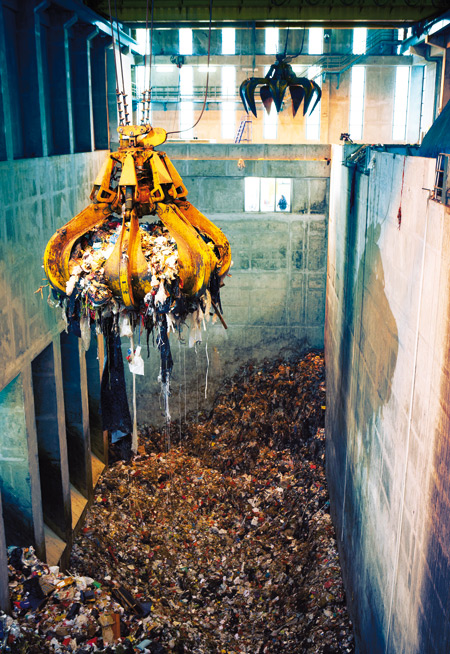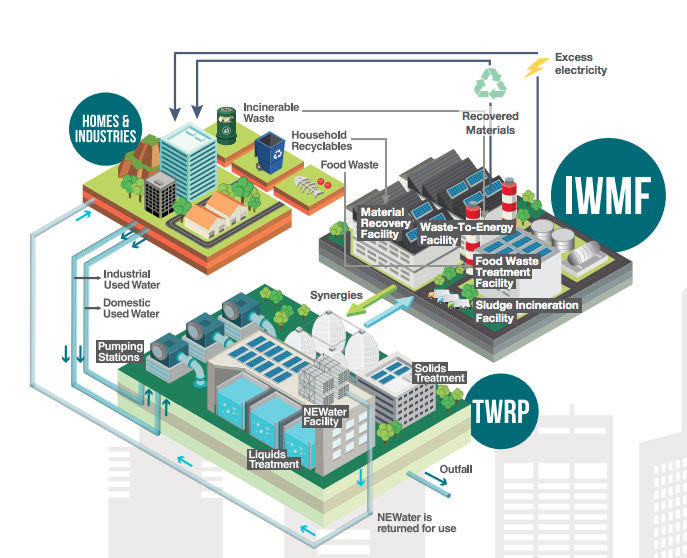Waste and Water
WASTE AND WATER
Combatting Waste Emissions
Singapore is embracing a shift towards a circular economy to reduce emissions, maximise resource efficiency and resilience, and conserve landfill space. The Government aims to improve Singapore’s overall recycling rate to 70% by 2030. The inaugural Zero Waste Masterplan was launched in 2019, and set an additional target to reduce the amount of waste sent to the landfill each day by 30% by 2030.
Singapore’s integrated solid waste management system focuses on two key thrusts – waste minimisation and recycling. In land-scarce Singapore, Waste-to-Energy (WtE) plants offer the best technical solution for waste treatment by reducing waste volume efficiently to conserve landfill space, and generating electricity to offset carbon emissions.
 Waste being prepared for incineration at the Keppel Seghers Tuas Waste-to-Energy plant. Besides diverting waste from landfills, incinerating waste also recovers heat energy that is used to produce and supply electricity to homes and factories. Image courtesy of Keppel Corporation Limited.
Waste being prepared for incineration at the Keppel Seghers Tuas Waste-to-Energy plant. Besides diverting waste from landfills, incinerating waste also recovers heat energy that is used to produce and supply electricity to homes and factories. Image courtesy of Keppel Corporation Limited.
The Resource Sustainability Act introduced in 2019 gave legislative effect to the regulatory measures targeting the three priority waste streams of e-waste, food waste and packaging waste, including plastics. Under the Act, the relevant producers are responsible for sustainable management of waste from their products at end-of-life.
Singapore has also introduced an Extended Producer Responsibility (EPR) scheme for e-waste and a Mandatory Packaging Reporting (MPR) scheme for packaging waste management. The Government plans to introduce a disposable carrier bag charge by mid-2023 and a beverage container return scheme by mid-2024 which will lay the foundation for an EPR framework for packaging waste management.
Reducing Energy Usage by Desalination
Desalinated water is one of Singapore’s water supply sources, meeting about 10% of the country’s water needs. We have been investing in research and development to improve the energy efficiency of the desalination process. One such project uses electrochemical desalting to reduce energy usage to less than half the volume currently being used by membrane-based desalination methods.
World’s First Integrated Waste and Water Treatment Facility
We also aim to maximise energy efficiency in our water and waste treatment operations. One key initiative being developed is the co-location of the Tuas Water Reclamation Plant (TWRP) and an Integrated Waste Management Facility (IWMF), collectively known as Tuas Nexus. It will harness synergies from the solid waste and used water treatment processes such as to generate enough electricity to sustain its own operations, with any excess electricity exported to the national grid. Tuas Nexus is expected to be completed in phases from 2026 onwards.
Tuas Nexus will include one of Southeast Asia’s largest sludge incineration plants, which will help to reduce direct methane emissions from wastewater sludge through incineration.
 Illustration of Tuas Nexus
Illustration of Tuas Nexus
Reducing Methane from Wastewater
Singapore is exploring how to reduce direct methane emissions from wastewater sludge through incineration. The Sumitomo Mitsui Banking Corporation and ECO-Special Waste Management (ECO-SWM) have collaborated on the development of one of Southeast Asia’s largest sludge incineration plants in Singapore.
With an estimated annual average reduction of 129,000 tonnes of carbon dioxide-equivalent (CO2e), the plant has been registered as an emissions reduction project with the United Nations Framework Convention on Climate Change and will generate carbon credits in Singapore.

